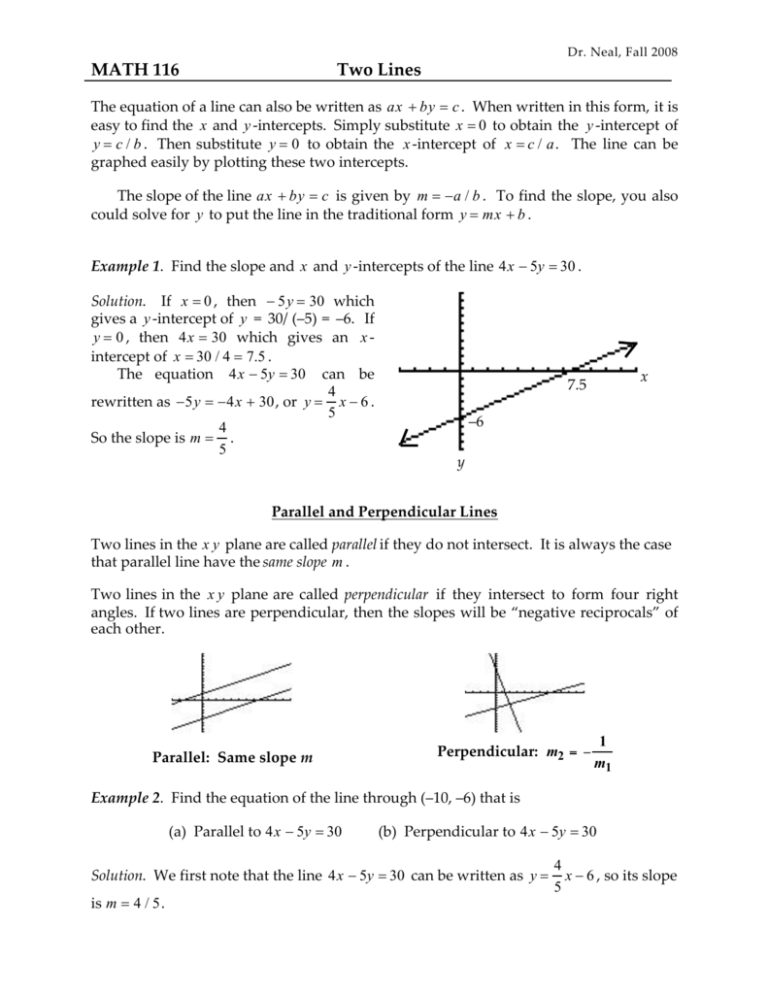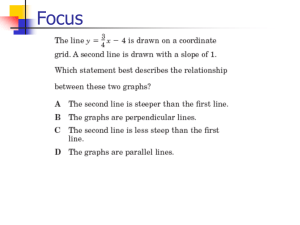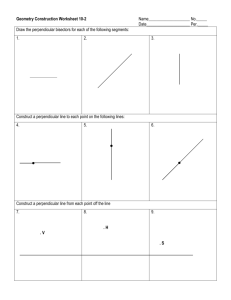MATH 116 Two Lines
advertisement

Dr. Neal, Fall 2008 MATH 116 Two Lines The equation of a line can also be written as ax + by = c . When written in this form, it is easy to find the x and y -intercepts. Simply substitute x = 0 to obtain the y -intercept of y = c / b . Then substitute y = 0 to obtain the x -intercept of x = c / a. The line can be graphed easily by plotting these two intercepts. The slope of the line ax + by = c is given by m = −a / b . To find the slope, you also could solve for y to put the line in the traditional form y = mx + b . Example 1. Find the slope and x and y -intercepts of the line 4x − 5y = 30 . Solution. If x = 0 , then − 5y = 30 which gives a y -intercept of y = 30/(–5) = –6. If y = 0 , then 4x = 30 which gives an x intercept of x = 30 / 4 = 7.5 . The equation 4x − 5y = 30 can be 4 rewritten as −5y = −4x + 30, or y = x − 6 . 5 4 So the slope is m = . 5 x 7.5 –6 y Parallel and Perpendicular Lines Two lines in the x y plane are called parallel if they do not intersect. It is always the case that parallel line have the same slope m . Two lines in the x y plane are called perpendicular if they intersect to form four right angles. If two lines are perpendicular, then the slopes will be “negative reciprocals” of each other. Parallel: Same slope m Perpendicular: m2 1 m1 Example 2. Find the equation of the line through (–10, –6) that is (a) Parallel to 4x − 5y = 30 (b) Perpendicular to 4x − 5y = 30 Solution. We first note that the line 4x − 5y = 30 can be written as y = is m = 4 / 5. 4 x − 6 , so its slope 5 Dr. Neal, Fall 2008 (a) Use m = 4 / 5 and point (–10, –6) to find the equation of a line y = mx + b : 4 4 4 (−10) + b → b = −6 + (10) = 2. So y = x + 2 is parallel to 4x − 5y = 30 and 5 5 5 goes through point (–10, –6). → −6 = 5 (b) We now use the negative reciprocal of slope 4/5. That is, we use m = − . Also, we 4 will use the alternate form of the equation of a line: y − y1 = m (x − x1 ) → y − (−6) = − 5 5 5 50 5 37 ( x − (−10)) → y + 6 = − ( x + 10 ) → y = − x − − 6 → y = − x − 4 4 4 4 4 2 Intersection of Two Lines If two distinct lines are not parallel, then they will intersect at one point. When we solve a system of two equations and two unknowns of the form ax + by = c dx+ey= f then we are actually trying to find the unique point of intersection. To solve such a system, we shall use the method of “elimination.” That is, multiply each equation by an appropriate constant to obtain the least common multiple of the x -coefficients a and d . Then add (or subtract) the resulting equations to eliminate the x -variable so that we can solve for y . Then substitute this y value into either equation to solve for x . Example 3. Find the point of intersection of the following pairs of lines: (a) −6x + 4y = 12 (b) 2x − 3y = 6 3x − 2y = −6 5x + 4y = 8 Solution. (a) Multiply the second equation by 3, then add equations: −6x + 4y = 12 − 6x + 4y = 12 → − 5y = 30 → y = −6 2x − 3y = 6 (× 3) → 6 x − 9y = 18 add Then 2x − 3y = 6 → x = (b) 3x − 2y = −6 (× 5) 5x + 4y = 8 (× − 3) Then x = 6 + 3y 6 + 3(−6) = = –6. 2 2 → So (–6, –6) is the point of intersection. 15x − 10y = − 30 27 → − 22y = −54 → y = 11 −15x − 12y = −24 add −6 + 2y −6 + 2(27 /11) −4 = = 3 3 11 (You can use the Frac command here.) Dr. Neal, Fall 2008 Exercises 1. Line 1 has equation −6x + 4y = 12 . Line 2 has equation 3x − 7y = 14. (a) (b) (c) (d) (e) Graph Line 1. What are the slopes and x and y -intercepts of Line 1 and of Line 2? Find the equation of the line through (–2, 4) that is parallel to the Line 1. Find the equation of the line through (–2, 4) that is perpendicular to Line 2. Find the point of intersection of Line 1 and Line 2. 2. Line 1 has equation 3x + 2y = 18. Line 2 has equation 4x + 3y = 12 . (a) (b) (c) (d) Graph Line 1. What is the slope of Line 2? Find the equation of the line through (–8, 10) that is perpendicular to Line 2 . Find the point of intersection of Line 1 and Line 2. Dr. Neal, Fall 2008 Solutions 1. (a) Line 1: −6x + 4y = 12 When x = 0 , then y = 3. When y = 0 , then x = − 2 . Plot line through (0, 3) and (–2, 0). y=3 6 (b) Line 1: 4y = 6x + 12 or y = x + 3. x =–2 4 Then m = 6/4 = 3/2. The x -int is –2 (occurs when y = 0). The y -int is 3 (occurs when x = 0). 3 Line 2: 3x − 14 = 7y or y = x − 2 . Then m = 3/7. The x -int is 14/3 and the y -int is –2. 7 (c) Line through (–2, 4) with slope m = 3/2: y= y−4= 3 3 ( x − (−2)) → y = (x + 2) + 4 → 2 2 3 x +7. 2 (d) Line through (–2, 4) with slope m = –7/3 (the neg. reciprocal of slope of Line 2.): 7 7 7 2 y − 4 = − ( x − (−2)) → y = − (x + 2) + 4 → y = − x − . 3 3 3 3 (e) −6x + 4y = 12 − 6x + 4y = 12 → −10y = 40 → y = −4 3x − 7y = 14 (× 2) → 6x − 14y = 28 add 14 + 7y 14 + 7(−4) 14 = = − . So (–14/3, –4) is the pt. of int. 3 3 3 -----------------------------------------------------------------2. (a) Line 1: x = 0 → y = 9 is the y -int. and y = 0 → x = 6 is the x -int. Then 3x − 7y = 14 → x = 9 (b) Line 2 has equation 3y = −4x + 12 → 4 y = − x + 4 ; so its slope is –4/3. 3 6 3 and point (–8, 10): 4 3 3 b = 10 + (8) = 16 → y = x + 16 . 4 4 (c) (d) x= Now use m = 3x + 2y = 18 (× 4) → 12x + 8y = 72 4x + 3y = 12 ( ×− 3) → −12x − 9y = −36 18 − 2y 18 − 2(−36) = = 30. 3 3 y= 3 x+b 4 → − y = 36 add → 10 = → y = −36 → So (30, –36) is the point of intersection. 3 (−8) + b 4 →





